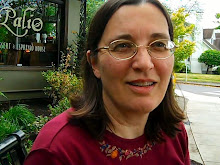A black man and a black woman stand on a street corner in inner but not Downtown Portland. She is talking with animated, but not wild gestures. (This is where her racial background is relevant; blacks tend to use bigger gestures than people of, for example, northern European descent.)
I had the length of the stoplight to ask, Is she angry? At the man she's talking to? What's their relationship? What's his reaction?
By the time I got my last glimpse, I had concluded that she was talking about something that angered her at the time, but now was an entertaining story. She had a residue of anger, but it was not directed at the man she was talking to. She knew the man, but he was a neighbor, a co-worker whom she had happened to run into, not a husband, brother, anything close like that. The man was enjoying the story.
But because I had been reading How to Read a Person Like a Book, I could take a little extra time and ask what I was basing the conclusions on.
First, the relationship. They stood at a 45-degree angle to each other, "open" to others joining the conversation, and their foreheads were not tense. The man had his ear turned attentively to the woman, and he was smiling slightly.
The anger was in the gestures, forceful, chopping motions, not arm-waving. Movements that if she had been angry at the man would have had her poking him in the chest. But she deflected them downward at the last instant. The object of her anger was absent.
Reading body language is for me at the core of people watching, and for a writer it can be an asset in characterization. If the author wants a character to reveal something without saying it, he can say it in movement. It's all part of "show, don't tell," and if, for example, a the writer wants to reveal that a child is afraid of her mother, she can flinch when another woman reaches out to stroke her hair. She can tend to stay to the side and behind adults.
Attraction, revulsion, desire, skepticism, boredom. We're always talking, even when we don't say anything. And we're always reading, if we pay attention, even if we haven't made use of a book to verbalize results.
Just for fun, check out a couple of paintings, Breaking Home Ties and Nighthawks and ask the questions: Who are they? Where are they coming from and where are they going? What is their relationship? How do they feel? And how do you know what you know?
And then at the mall or on the street corner, the game continues, and characters say more than they ever could in words.
I had the length of the stoplight to ask, Is she angry? At the man she's talking to? What's their relationship? What's his reaction?
By the time I got my last glimpse, I had concluded that she was talking about something that angered her at the time, but now was an entertaining story. She had a residue of anger, but it was not directed at the man she was talking to. She knew the man, but he was a neighbor, a co-worker whom she had happened to run into, not a husband, brother, anything close like that. The man was enjoying the story.
But because I had been reading How to Read a Person Like a Book, I could take a little extra time and ask what I was basing the conclusions on.
First, the relationship. They stood at a 45-degree angle to each other, "open" to others joining the conversation, and their foreheads were not tense. The man had his ear turned attentively to the woman, and he was smiling slightly.
The anger was in the gestures, forceful, chopping motions, not arm-waving. Movements that if she had been angry at the man would have had her poking him in the chest. But she deflected them downward at the last instant. The object of her anger was absent.
Reading body language is for me at the core of people watching, and for a writer it can be an asset in characterization. If the author wants a character to reveal something without saying it, he can say it in movement. It's all part of "show, don't tell," and if, for example, a the writer wants to reveal that a child is afraid of her mother, she can flinch when another woman reaches out to stroke her hair. She can tend to stay to the side and behind adults.
Attraction, revulsion, desire, skepticism, boredom. We're always talking, even when we don't say anything. And we're always reading, if we pay attention, even if we haven't made use of a book to verbalize results.
Just for fun, check out a couple of paintings, Breaking Home Ties and Nighthawks and ask the questions: Who are they? Where are they coming from and where are they going? What is their relationship? How do they feel? And how do you know what you know?
And then at the mall or on the street corner, the game continues, and characters say more than they ever could in words.
Powered by ScribeFire.
